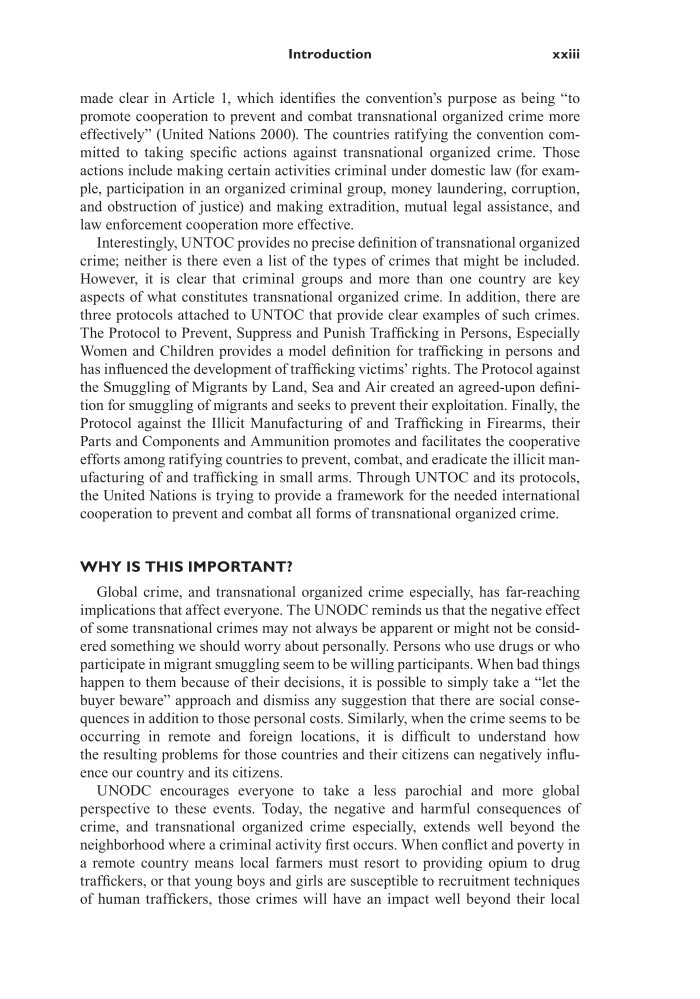Introduction xxiii made clear in Article 1, which identifies the convention’s purpose as being “to promote cooperation to prevent and combat transnational organized crime more effectively” (United Nations 2000). The countries ratifying the convention com- mitted to taking specific actions against transnational organized crime. Those actions include making certain activities criminal under domestic law (for exam- ple, participation in an organized criminal group, money laundering, corruption, and obstruction of justice) and making extradition, mutual legal assistance, and law enforcement cooperation more effective. Interestingly, UNTOC provides no precise definition of transnational organized crime neither is there even a list of the types of crimes that might be included. However, it is clear that criminal groups and more than one country are key aspects of what constitutes transnational organized crime. In addition, there are three protocols attached to UNTOC that provide clear examples of such crimes. The Protocol to Prevent, Suppress and Punish Trafficking in Persons, Especially Women and Children provides a model definition for trafficking in persons and has influenced the development of trafficking victims’ rights. The Protocol against the Smuggling of Migrants by Land, Sea and Air created an agreed-upon defini- tion for smuggling of migrants and seeks to prevent their exploitation. Finally, the Protocol against the Illicit Manufacturing of and Trafficking in Firearms, their Parts and Components and Ammunition promotes and facilitates the cooperative efforts among ratifying countries to prevent, combat, and eradicate the illicit man- ufacturing of and trafficking in small arms. Through UNTOC and its protocols, the United Nations is trying to provide a framework for the needed international cooperation to prevent and combat all forms of transnational organized crime. WHY IS THIS IMPORTANT? Global crime, and transnational organized crime especially, has far-reaching implications that affect everyone. The UNODC reminds us that the negative effect of some transnational crimes may not always be apparent or might not be consid- ered something we should worry about personally. Persons who use drugs or who participate in migrant smuggling seem to be willing participants. When bad things happen to them because of their decisions, it is possible to simply take a “let the buyer beware” approach and dismiss any suggestion that there are social conse- quences in addition to those personal costs. Similarly, when the crime seems to be occurring in remote and foreign locations, it is difficult to understand how the resulting problems for those countries and their citizens can negatively influ- ence our country and its citizens. UNODC encourages everyone to take a less parochial and more global perspective to these events. Today, the negative and harmful consequences of crime, and transnational organized crime especially, extends well beyond the neighborhood where a criminal activity first occurs. When conflict and poverty in a remote country means local farmers must resort to providing opium to drug traffickers, or that young boys and girls are susceptible to recruitment techniques of human traffickers, those crimes will have an impact well beyond their local
Document Details My Account Print multiple pages
Print
You have printed 0 times in the last 24 hours.
Your print count will reset on at .
You may print 0 more time(s) before then.
You may print a maximum of 0 pages at a time.




























































































































































































































































































































































































































































































































































































































































































































































































































































































